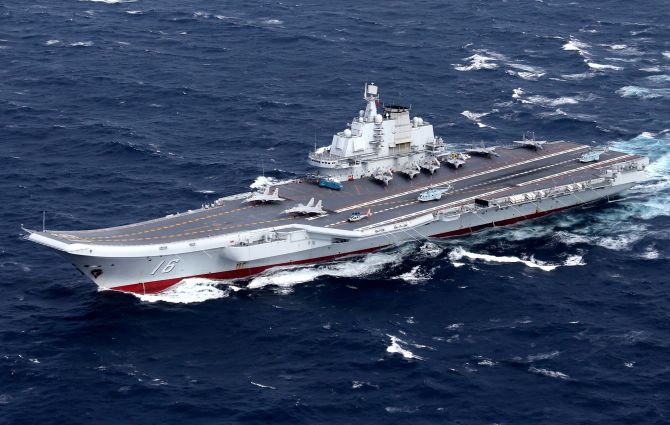Last week, when the China Central Television showed live the People’s Liberation Army Navy’s (PLAN) third aircraft carrier Fujian leaving the Jiangnan Shipyard in Shanghai, the message to the world was loud and clear.
The 80,000 metric tonne mammoth, Type 003 class warship, which was on its maiden sea trial, has put PLAN way ahead of many other navies.
Only the Nimitz class (87,000 metric tonnes) and Gerald R. Ford class (100,000 metric tonnes) aircraft carriers of the US Navy are bigger than the Fujian.
The Chinese carrier underscores Beijing’s ambition to assert itself as a major maritime force on the global stage.
Around 42 aircraft carriers are in operation by 13 navies around the world. But it is PLAN’s pace of expansion on this front that naval observers find impressive.
In 2012, China commissioned its first aircraft carrier Liaoning; the second carrier, Shandong, was launched in 2019.
While Shandong is the first indigenous Chinese carrier, Liaoning was rebuilt on a gutted, unfinished Ukrainian aircraft carrier hull.
PLAN has an ambitious goal of building a fleet of over 10 aircraft carriers by 2050. As China eyes greater dominance in the Indian Ocean Region, the Indian Navy, still awaiting its third aircraft carrier, has some catching up to do.
Interestingly, India became the first Asian country in 1961 to acquire an aircraft carrier—the HMS Hercules from the UK.
It now operates two aircraft carriers—INS Vikramaditya, acquired from Russia, and INS Vikrant, the country’s first Indigenous Aircraft Carrier (IAC-1). INS Vikrant has 14 decks and 2,300 compartments, and can accommodate a crew of 1,700.
A comparison of China’s rapid aircraft carrier development and India’s slow progress in this points to strategic considerations in naval development.
While China is swiftly advancing its capabilities with Fujian, India’s plans for a third aircraft carrier, the IAC-2, are pending approval.
The debate within the Indian military establishment, over the comparative importance of aircraft carriers and submarines, has delayed the third aircraft carrier programme to some extent.
As China aims for over 10 aircraft carriers by 2050, there’s growing pressure on India to accelerate its naval modernisation to maintain the balance of power in the Indian Ocean Region.
Last November, to get a third aircraft carrier as early as possible, the Defence Procurement Board moved the proposal before the government, but it is still awaiting a go-ahead from the defence ministry.
Moreover, the naval headquarters is working on plans for larger aircraft carriers.
The IAC-2 is expected to have a displacement of 45,000 tonnes and cost around Rs 40,000 crore.
It will be built by Cochin Shipyard Limited and modelled on INS Vikrant, which was commissioned in September 2022.
It is notable that India’s aircraft carrier project has hit delays amid the carrier vs submarine debate.
Naval experts argue that both submarines and aircraft carriers are critical.
While submarines are best for sea denial, aircraft carriers are needed for sea control and power projection.
In military parlance, sea control is exercised using a combination of warships, fixed-wing aircraft, helicopters and amphibious capabilities whereas a sea denial strategy means denying the enemy use of a sea area for a certain period of time.





